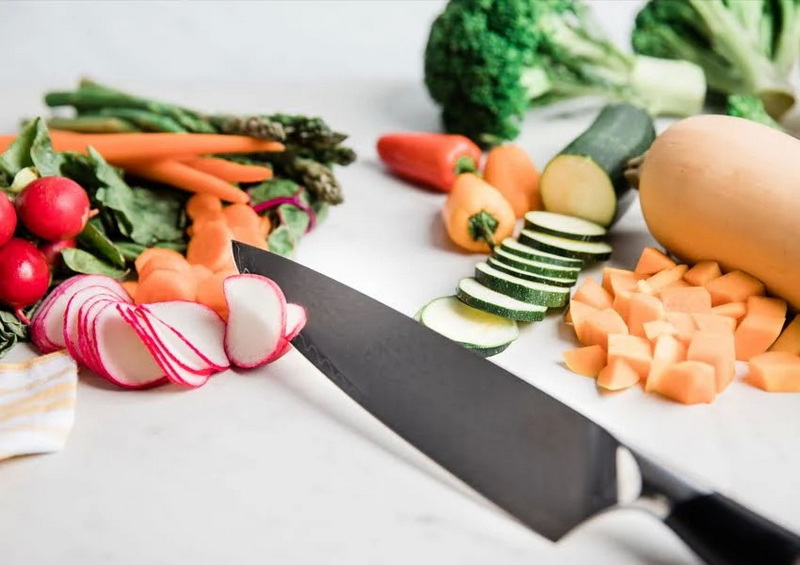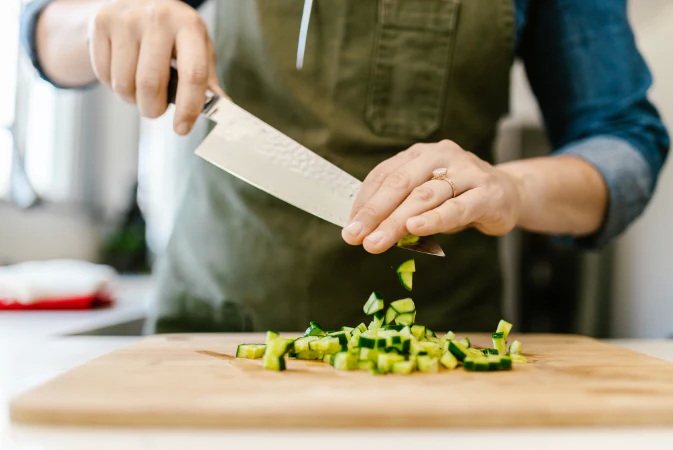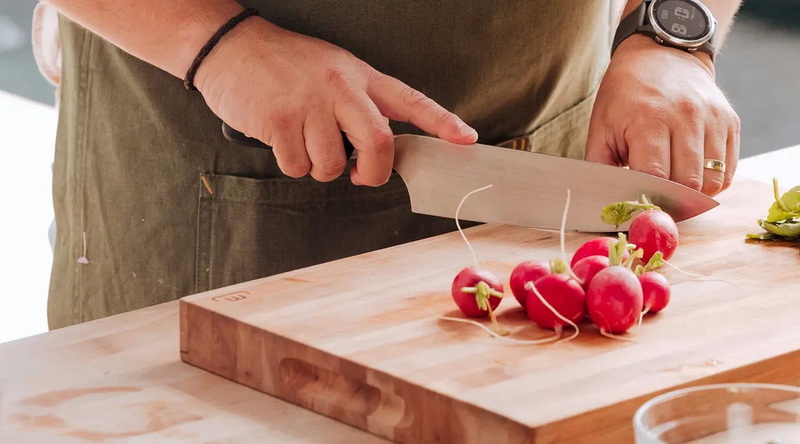









Content Menu
>> Key Features of a Vegetable Knife
● Types of Vegetable Knives and Their Uses
>> Nakiri Knife
>> Usuba Knife
>> Tomato Knife
● How to Hold a Vegetable Knife Properly
● Basic Vegetable Cutting Techniques Using a Vegetable Knife
● Advanced Japanese Vegetable Cutting Techniques
● Choosing the Right Vegetable Knife for Your Kitchen
● Step-by-Step Guide to Using a Vegetable Knife
● Safety Tips When Using a Vegetable Knife
● Maintenance and Care for Your Vegetable Knife
● Vegetable Knife vs. Chef Knife: What's the Difference?
● FAQ
>> 1. What is the difference between a Nakiri and a Usuba knife?
>> 2. Can I use a vegetable knife for fruits?
>> 3. How do I maintain the sharpness of my vegetable knife?
>> 4. Is a vegetable knife suitable for cutting meat?
>> 5. What is the best way to hold a vegetable knife for safety and control?
Using a vegetable knife effectively is an essential skill for anyone who enjoys cooking fresh, vibrant dishes. Vegetable knives, such as the Nakiri or other specialized blades, are designed to make cutting, chopping, slicing, and peeling vegetables easier, safer, and more precise. This comprehensive guide will walk you through everything you need to know about using a vegetable knife, including techniques, safety tips, and maintenance advice. Along the way, you will find detailed instructions and explanations to help you master this indispensable kitchen tool.
A vegetable knife is a specialized kitchen knife primarily designed for preparing vegetables and fruits. Unlike general-purpose knives, vegetable knives often have a straight, flat blade that allows for clean, even cuts without rocking the blade too much. This design is perfect for chopping, dicing, and slicing vegetables with precision and ease.

- Flat blade: Most vegetable knives have a flat edge that contacts the cutting board fully, making chopping and dicing more efficient.
- Wide blade: The broad blade allows you to scoop and transfer chopped vegetables easily.
- Shorter length: Vegetable knives tend to be shorter than chef's knives, offering better control for detailed work.
- Sharp, thin edge: This helps in making precise cuts, including thin slices and julienne strips.
One of the most popular types of vegetable knives is the Nakiri, a traditional Japanese knife with a rectangular blade and a double-edged design. It excels at chopping vegetables evenly and finely, making it a favorite in both professional and home kitchens.
The Nakiri knife features a straight, rectangular blade with a double bevel, meaning it is sharpened on both sides. This makes it versatile and user-friendly, ideal for chopping, slicing, and dicing vegetables. Its flat blade allows for clean cuts all the way through the vegetable without the need for a rocking motion.
The Usuba is a traditional Japanese vegetable knife with a single bevel, sharpened on only one side. This design allows for ultra-thin and delicate cuts, perfect for intricate vegetable garnishes and decorative slicing. However, it requires more skill to use and sharpen than the Nakiri.
Smaller knives like peeling knives and paring knives complement the vegetable knife by handling finer tasks such as peeling, shaping, and trimming vegetables and fruits. Their curved blades allow precision in shaping round vegetables like potatoes and apples.
A tomato knife has a small serrated blade designed to cut through the tough skin of tomatoes and other soft fruits without crushing them.
Proper grip and hand placement are crucial for safety and control when using a vegetable knife.
- Pinch grip: Hold the knife handle with your thumb and index finger pinching the blade just above the handle, while the other fingers wrap around the handle. This grip offers excellent control.
- Hammer grip: Hold the handle like a hammer, which is less precise but useful for heavy chopping.
- Guide hand: Curl the fingertips of your non-cutting hand inward, forming a claw shape. Use your knuckles as a guide for the blade to prevent cutting your fingers.
- Place the vegetable on a stable cutting board.
- Use the flat blade to press down and push forward in a smooth motion.
- Keep the tip of the knife close to or touching the board to maintain control.
- Use a push-cut motion rather than a rocking motion for cleaner cuts.
Julienning means cutting vegetables into thin, matchstick-like strips, ideal for salads, stir-fries, or garnishes.
- Cut the vegetable into even planks about 3-4mm thick.
- Stack the planks and slice them into thin strips of equal width.
- Use a sharp vegetable knife for precision.
- Keep your guide hand fingers curled to avoid injury.
Cutting vegetables diagonally increases surface area and visual appeal.
- Cut the vegetable lengthwise in half to create a flat surface.
- Slice at a 45-degree angle, maintaining even thickness.
- This technique is excellent for cucumbers, zucchini, and carrots.
Use smaller knives like peeling or turning knives for peeling and shaping round vegetables. The curved blade allows you to remove thin layers of skin or shape vegetables for presentation.
Japanese cuisine uses several specialized cuts that can be mastered with a vegetable knife:
- Wa-giri (Round slices): Circular slices for carrots, cucumbers, and daikon.
- Hangetsu-giri (Half-moon slices): Cut vegetables in half lengthwise, then slice.
- Icho-giri (Ginkgo leaf slices): Quarter-round slices, perfect for soups.
- Ran-giri (Random cuts): Irregular shapes that cook evenly.
- Hyoushigi-kiri (Wood clapper cuts): Long rectangular sticks.
- Kakugiri (Cube cuts): Dice vegetables into cubes after slicing into strips.
These cuts enhance both the texture and presentation of dishes and are achievable with practice using a vegetable knife.

When selecting a vegetable knife, consider the following:
- Blade type: Double-beveled knives like the Nakiri are easier for most home cooks, while single-beveled knives like the Usuba are better for advanced users.
- Blade size: Choose a blade size that feels comfortable in your hand and suits the size of vegetables you typically prepare.
- Handle comfort: Look for a handle that provides a secure grip and feels balanced.
- Material: High-carbon stainless steel blades hold sharpness well and resist rust.
For general vegetable preparation, a Nakiri knife is often the best choice due to its versatility and ease of use.
1. Prepare your workspace: Use a stable, non-slip cutting board. Make sure your knife is sharp.
2. Wash and peel vegetables: Clean your vegetables and peel if necessary.
3. Create a flat surface: Cut a thin slice off one side of round vegetables to prevent rolling.
4. Grip the knife: Use the pinch grip for control.
5. Position your guide hand: Curl your fingers inward, using knuckles as a guide.
6. Cut with a push-forward and pull-back motion: Let the flat blade glide through the vegetable smoothly.
7. Use the wide blade to scoop: Transfer chopped vegetables easily to your cooking vessel or bowl.
- Always cut away from your body.
- Keep your fingers curled and away from the blade.
- Use a sharp knife to reduce slipping.
- Secure your cutting board on a flat surface.
- Never use the same knife for raw meat and vegetables without cleaning to avoid cross-contamination.
- Carry the knife with the blade pointed down.
- Do not leave knives loose on countertops.
- Sharpen regularly: Use a whetstone or knife sharpener to maintain a keen edge.
- Hand wash only: Avoid the dishwasher to preserve the blade and handle.
- Dry immediately: Prevent rust and corrosion.
- Store safely: Use a knife block or magnetic strip to protect the blade and your fingers.
While both knives are essential in the kitchen, they serve different purposes:
Feature | Vegetable Knife (Nakiri) | Chef Knife |
Blade Shape | Straight, rectangular | Curved with pointed tip |
Cutting Motion | Push-cut, straight down | Rocking motion |
Primary Use | Vegetables and fruits | Versatile: meat, vegetables, fish |
Edge Type | Thin, flat edge | Thicker, curved edge |
Ease of Use | Easier for precise vegetable cuts | More versatile but requires skill |
The vegetable knife is designed specifically for vegetable preparation, offering clean cuts without crushing, while the chef knife is an all-purpose tool suited for a variety of kitchen tasks.
Mastering the use of a vegetable knife transforms your cooking experience, making vegetable preparation faster, safer, and more precise. Whether you are chopping, slicing, julienning, or peeling, the right technique combined with a well-maintained vegetable knife will elevate your culinary skills. The Nakiri knife, with its straight, double-edged blade, is particularly versatile and user-friendly, making it ideal for both beginners and experienced cooks. Practice the grips, cutting motions, and safety tips outlined in this guide to become confident and efficient in your kitchen.

The Nakiri is a double-beveled vegetable knife with a straight blade, suitable for general vegetable cutting, while the Usuba is single-beveled, designed for delicate, precise cuts and decorative garnishes, but requires more skill.
Yes, vegetable knives are excellent for fruits as well, especially for peeling and slicing. Their sharp, precise blades allow you to remove thin layers of skin and make clean cuts without crushing soft fruits.
Regularly sharpen your knife using a whetstone or sharpener. Hone the edge frequently to maintain sharpness, and always hand wash and dry the knife immediately after use to prevent rust.
Vegetable knives are primarily designed for vegetables and fruits. While they can slice boneless meat thinly, they are not ideal for cutting through bones or tougher cuts, where a chef's or boning knife is more appropriate.
Use the pinch grip by pinching the blade near the handle with your thumb and index finger while wrapping the other fingers around the handle. Keep your guide hand curled in a claw shape to protect your fingertips.